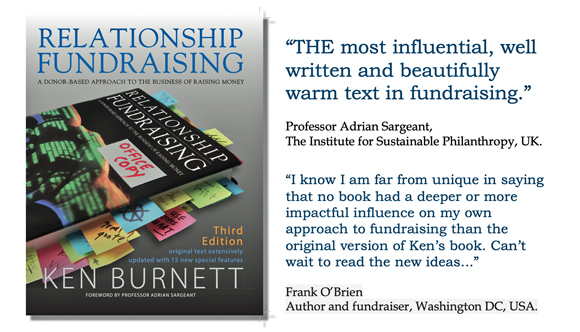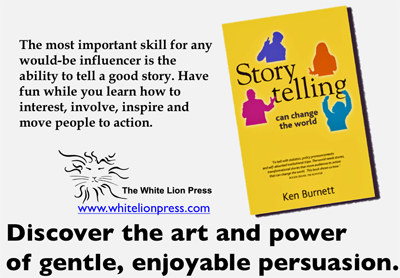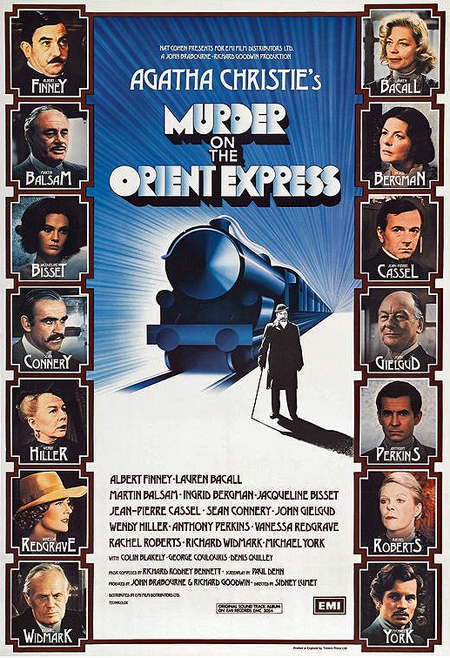| |
|
In Agatha Christie’s classic Murder on the Orient Express an assortment of passengers are marooned with a murderer on a train stuck in a Yugoslavian snowdrift, with only little Hercule Poirot to help them work out what’s really going on.
The story seems to me an analogy for how we fundraisers might work ourselves out of the fix we find ourselves in, with our equivalent of being stuck fast in snow – the negative view the public has for our most successful method of acquiring new donors in volume, face-to-face fundraising on the street (F2F) or door-to-door (D2D).
Poirot’s suspects, like us, are stuck fast, not getting to where they want to be. Though it seems unlikely at first, events as they unfold show they’re all in this situation together. So they all have a stab at the problem. When they work together they demonstrate surprising creativity and unity. And they succeed, big time.
OK, it’s not a perfect analogy. For a start I couldn’t think who should play the Belgian. I’m too tall, have no wondrous moustaches and my little grey cells function less well than once they did. So for this important problem I thought I’d ask a few fellow travellers. When it comes to digging our way out of our equivalent of deep snow, they’re more likely to find a way than I.
I like to think I’m not easily impressed. I’m into my 35th year as a fundraiser so I’ve been around the block a few times and I’ve seen a few things too. For me, the fundraiser who’ll earn my respect, who I will revere, is he or she who can come up with a way to improve public perception of fundraising generally and street and door-to-door fundraisers in particular.
What a force for good he or she will be. Anyone who can do that will really change the world, for good, for sure.
Realistically though it won’t just be one single big breakthrough that will dig us out of our particular snowdrift and so bring about a real change in how our publics view us. Rather it’ll involve a flurry of small improvements that cumulatively and hopefully over not too much time will add up to a different perception of why we do what we do, and how.
It’s the one area where I think there’s most opportunity for dramatic improvement. Why? Because these relatively new methods of fundraising have been so structured that they’re starved of creative input. They’re so driven by the imperative of keeping acquisition costs low they’ve been denied almost any investment.
Which means, they’re nowhere near as good as they could be, if we creative fundraisers were to really apply ourselves to the task of making them better.
Leastwise, that’s what I think. And others feel as I do, I know. That’s why I issued a challenge to a few bright fundraising friends, to help find ways that might dig us out. Here’s a bit of what I said to them:
The term ‘chugger’ suggests a public deeply fearful of and resistant to being stopped as they go about their business by the likes of us. So how could we enhance their experience, for the benefit of both charities and public alike? If passing people could realise the huge number of new donors and volume of money that street fundraisers bring in and the consequent good that charities can do as a result they might view the process more positively. How can a charity get this across, on the street or doorstep? What words, pictures and statistics could street fundraisers employ? What emotions, feelings, stories, experiences could fundraisers communicate, and how? With what music, sounds, smells, tastes, competitions and involvement devices, endorsements, electronic gizmos, screens, counters, calculators, poems, jokes, dances, drama, dressing-up, street theatre, intrigue...? How could other street users be persuaded to join in...?
So, that’s the brief. From what these bright folks have come up with, I think we’ve uncovered a rich seam of fundraising innovation and a few ideas that individually or together might just change for the better the way the public views the work we do. And we haven’t had your input yet…
Grouping ideas
First reaction from Aline Reed, creative director at the Bluefrog agency, was to ask, ‘Do fundraisers actually practise face-to-face fundraising?
‘What they really do,’ Aline says, ‘is just face-to-face recruitment – sending teams out on the streets to get new donors. An uninspired interaction is then followed by the same cycle of communications every other donor receives, without any choice. It’s often not rewarding or inspiring. Unsurprisingly, attrition is massive.’
Good thinking. Clearly, we’ve got to think differently not just about how we interact with people when we meet them face to face, but how we follow them up too.
I’ve deliberately not allowed the ideas that follow to be channelled or confined by regulation or codes of practice. Some of these may be outside current accepted thinking but none are beyond the pale.
Lots of the people I asked believe strongly in what we might call ‘theatre’. ‘Behind every great proposition is drama,’ says Tim Longfoot, MD at Open Fundraising. So we have to get over practical issues, such as fundraisers can’t carry props, distribution, etc.
But, as Tim says, if a charity talks about malaria its fundraisers could carry mosquito nets. For malnutrition, the fundraisers could show and talk about Plumpy Nuts. For a childcare charity fundraisers could carry a hand held computer, typing in people’s postcodes to show the number of kids at risk in their neighbourhood. And so on.
First though, we need to correct what’s wrong
If we want F2F fundraisers to be loved (as much as fundraisers ever are) there are some fundamental issues to address.
- F2F fundraisers can’t be seen to be a gang rolling out of a van to represent one cause one week and another the next, simply by changing a tabard.
- They can’t be seen to continually ‘pester’ people living and working in particular areas.
- Fundraisers need to be more than cold callers . They should be committed to their calling, not just resting actors and unemployed graduates doing an unpleasant job as a stopgap.
- Staff turnover means people don’t always get the best training. Fundraising clients often don’t invest enough time and energy to ensure their fundraisers receive inspirational training.
- Targeting is virtually impossible. Some donors simply can’t afford regular commitment, but could still give.
- Direct debit is very inflexible. It’s either off or on. If you’re having a tricky month you can’t skip. That could change.
Fundamental principles
- Don’t interrupt, start a conversation.
- Entertain, don’t irritate.
- Excite and inspire.
- Inform and explain.
- Use technology better.
- Look better/ more interesting. Dress up. Use posters. Catch the eye.
- Be specific. Quote statistics. ‘Last week this team helped 500 blind children find their way in life.’ Or, ‘Last year street fundraisers recruited 730,269 new donors who each year will give more than £20 million to help good causes around the world. Year after year.’
- We can incentivise fundraisers.
- Use techniques that have been proved to work in other areas of fundraising. Adapt them for F2F and D2D.
- If you can’t defend it vigorously, don’t do it.
Ideas worth testing
- Two stage. Don’t ask at the first encounter. Instead, give something to those who stop to talk. Make the first ask very soft, ask only for data, or agreement to sign up to the charity’s newsletter. If for D2D combine with clothing collection (where appropriate). Then upgrade.
- Why aren’t charities rewarding their fundraisers with certificates telling them how much money they’ve raised? Thank you – you’ve helped answer 480 calls from desperately vulnerable young children. Or whatever.
- Recruit service users as face-to-face fundraisers. One charity (their main job is to get injured servicemen back to work) employs injured service people who want to retrain in sales or marketing as street fundraisers. Just think of the opportunity.
‘Hello, my name’s Private Peter Sharpe. I lost an arm in Afghanistan - see. I’m proud that EVERY PENNY I raise goes to pay my wages. That’s the point of our charity you see… Please sign up, because I need 100 sign ups to qualify for this segment of my NVQ…. And loads of my mates need your help too. Let me tell you about Stuart. He can’t do what I am doing, because he lost his legs…. but he would love to learn to do….’
Continues top of column two, above



Ken Burnett’s Storytelling can change the world
is reviewed here and here and you can buy it here.
|
|
 A whodunnit with a difference. While stuck in the snow everyone can have a stab at being the murderer. And at solving the crime. With special thanks to my fellow passengers F2F and D2D fundraisers everywhere, plus Aline Reed, Paul Stein, James Briggs, Craig Linton, Tim Longfoot, Alan Clayton and Giles Pegram CBE. And to you too, I hope. A whodunnit with a difference. While stuck in the snow everyone can have a stab at being the murderer. And at solving the crime. With special thanks to my fellow passengers F2F and D2D fundraisers everywhere, plus Aline Reed, Paul Stein, James Briggs, Craig Linton, Tim Longfoot, Alan Clayton and Giles Pegram CBE. And to you too, I hope.
Continued from end of column one, below
- Make sure fundraisers work in places that are meaningful – like the place their charity was founded or two streets away from a hospice or centre. Or they could be outside a shop that has agreed to match/part-match whatever gift they give.
- Give an involvement device of the kind that work so well in direct mail, eg give passers-by a piece of plastic to look through that shows them what it’s like to have a cataract. Or for a development charity, try ‘twin’ towns for the day – creating a link between, say, Worcester and Mumbai.
- Make fundraising location specific. Offer the sense of community that people value so much. Get a team on the streets just to say thank you to the people of St Ives, or Aberdeen, or wherever. They could give people thank-you cards, showing the photo of, for instance, a child whose life has been saved by funds raised in St Ives.
- Make sign up quicker and easier by just getting people to text agreement then calling back – rather than filling out a long form. Or get them to sign up online. The focus of the conversation could then change to how we show you your money has made a difference.
- Improved ongoing communication can reduce attrition. Bluefrog has developed U-Space, used by several charities to give every new donor their own website, where they receive regular updates on the impact of their gift. Crucially, donors can also increase/decrease/cancel/take a holiday from their gift at the touch of a button or two. It also has a social aspect so donors can comment on posts or rate them. And the donor can choose what other communications they get.
- Recruit older F2F and D2D fundraisers.
- Move from cold contacts to warm leads. This could mean a F2F fundraiser working in their own community, using their personal networks to recruit. Prospecting could be done online, using social networks to identify people who are already involved and interested.
- Incentivise people to stop by giving them something they will value, such as a limited edition t-shirt, badge, pin, etc.
- Tell richer, more interactive stories. Use iPads and mobiles.
- Be less generic. Give thought to targeting, with a different message and different propositions for different types of prospect, eg talk to girls about periods (seriously). When girls in Africa get their first period that can mean their last lesson…
- Choice is a great way to engage with people that’s not used enough. What areas of our work are you interested in, etc? How much do you want to give (don’t start high).
- Share is hardly used. Get people excited about joining the team - ask new donors to share the proposition with friends and family. Personal recommendations reduce attrition.
- Mobile phones might work best for involvement and stewardship. Get mobile numbers and start texting thank-you messages with links to cool, engaging, rich and rewarding content. Link mobile to Facebook.
- Give handouts. Thank. Reassure. Inspire. Tell donors, ‘You made the right decision. Here’s what you can expect from us (evidence that you’re helping change the world), what we expect from you (keep giving, tell your friends etc).’ Then give them cool things to brand themselves. Self-definition is great tool to reduce attrition. Badges, stickers etc.

OK, it’s not a perfect analogy. For a start I couldn’t think
who should play the Belgian. I’m too tall, have no
wondrous moustaches and my little grey cells function
less well than once they did. So for this important problem
I thought I’d ask a few fellow travellers.

More specific ideas
- Decorate your fundraisers as appropriate.
- Use sound.
- Wow! The show. Street theatre. Drama.
- Posters and point of sale, including electronic posters.
- Always equip teams with two pieces of information.
- What this team achieved last week.
- Why you should stop for street fundraisers (total achievement poster).
- For conversation starters study Hugh McLeod (www.gapingvoid.com).
- Fundraisers should always stop to speak to F2F and D2D people, just to say, ‘Well done, you’re doing a great job.’
- Fundraisers should publicly stand up for F2F.
How we can make street fundraising a more socially welcome experience:
- Entertain. Be loud, active, interesting, fun.
- Don’t stop passers-by. Like street entertainers, get the donor to come to you.
- Animal charities – fundraisers dress up in animal costumes and get them to do something entertaining like juggling, fire-eating or singing and dancing. As the crowd gathers engage them about the cause and get them signed up.
- Hospices – get the fundraisers dressed as doctors and nurses. Get a portable bed that be taken on the streets, ask people to lie in it, create a story around the experience.
- Lifeboats, Red Cross, Amnesty, Greenpeace, Unicef, ActionAid you can all do street theatre. So can most organisations. If not an animal charity or one of these others, what have you got? History? Dramatic images… what can you do that will stop people in their tracks so they say ‘Wow, what’s that?’, then want to interact?
- Commission a stand-up comedy script about your charity and the beneficiaries. If it’s good enough deliver it in public or via video from a well known comedian.
- Use music and sound to inspire donors. Have an iPod with a track about your cause and ask donors how it makes them feel. Let them listen to a beneficiary explaining why the cause is important.
- Short films, or even charity ads can be shown now on iPads. These could be used to engage people when speaking to them. Would need to be short, and could also help to get over the issue of distrust / doubt over the F2F agency’s links to the charity. They could include a message from the CEO explaining that the fundraiser is a representative of the charity, asking the prospective donor just to give five minutes of their time.
- Our payment model hasn’t changed since F2F first started. It could change so small gifts and one off donations shouldn’t be rejected, but embraced and encouraged with bonuses for data capture and large or regular direct debits.
This start comes with grateful thanks to Aline Reed, Paul Stein, James Briggs, Craig Linton, Tim Longfoot, Alan Clayton, Giles Pegram CBE and the inspirational fundraisers I meet on the street.
But it is just a work in progress. Have you got ideas that you’d like to share, for improving fundraising on the street, particularly for enhancing the public’s experience of it? Email me here. For background on this subject see my earlier articles, here.
© Ken Burnett 2011
Links to related articles on face-to-face fundraising:
• How we treat F2F fundraisers.
• Thank you, street fundraiser: a meeting on the street
• It’s not what you do, it’s the way that you do it.
ooooo
At the time of writing Ken Burnett is a director of Clayton Burnett Limited, The White Lion Press Limited and he’s a former chairman of the board of trustees at the international development charity ActionAid. He’s author of several books including Relationship Fundraising and The Zen of Fundraising and is managing trustee of SOFII, The Showcase of Fundraising Innovation and Inspiration. For more on Ken’s books please click here.
|




 A whodunnit with a difference. While stuck in the snow everyone can have a stab at being the murderer. And at solving the crime.
A whodunnit with a difference. While stuck in the snow everyone can have a stab at being the murderer. And at solving the crime.